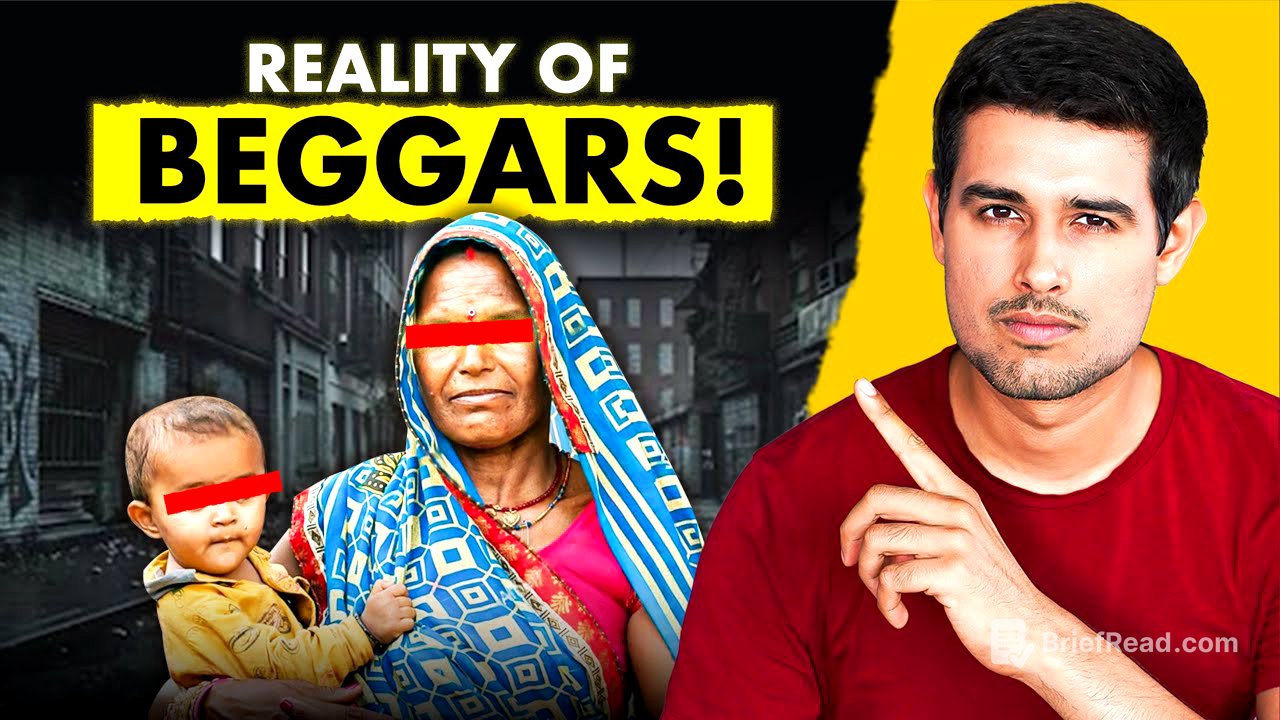TLDR;
This video exposes the harsh realities of the beggar mafia in India, a criminal network exploiting vulnerable individuals, including children, for profit. It highlights the reasons behind begging, the economics of it, the methods used by the mafia, and the government's ineffective responses. The video suggests practical ways individuals can help without contributing to the exploitation, such as providing food or supporting NGOs.
- The beggar mafia is a sophisticated criminal network that exploits vulnerable people for profit.
- Many people are driven to begging due to poverty, unemployment and helplessness.
- The government's response to begging has been largely ineffective, often targeting the victims rather than the perpetrators.
- Individuals can help by providing food, clothing, or medicines directly to beggars, or by supporting NGOs that work to rehabilitate them.
Introduction to the Beggar Mafia [0:00]
The video starts by describing the disturbing reality of begging gangs in India, where children are rented and drugged to solicit more money. Women are forced to cross-dress as different religions to beg in front of temples and mosques. It highlights the story of Suresh Manji, who was kidnapped, tortured, and forced into begging, illustrating the cruelty and scale of the beggar mafia. This criminal network operates as a ₹1.5 trillion industry, affecting hundreds of thousands of people, especially children and women. The video aims to explore where the money goes, how much beggars earn, how the mafia operates, and potential solutions.
Reasons Behind Begging [5:33]
Based on a 2021 report, the video identifies two primary reasons for begging: helplessness and choice. Helplessness includes poverty (62%), unemployment (45%), old age, disability, sickness (24%), being widowed (6%), and addiction (3%). Some individuals turn to begging after losing their jobs. On the other hand, some people beg by choice, considering it easy money (12%), out of habit (7%), for hereditary reasons (6%), or for religious reasons (3%). The report also found that about 20% of beggars engage in part-time work to supplement their income due to job insecurity and low wages.
Earnings of Beggars [7:04]
The video addresses misconceptions about beggars' earnings, citing the report that 32% earn less than ₹100 per day, 33% earn between ₹100-₹200, 22% earn between ₹200-₹400, and only 1% earn more than ₹400. This means the majority earn between ₹3,000-₹6,000 per month, which is less than the minimum wage for unskilled laborers in Delhi (₹15,908). Many beggars, especially those controlled by the mafia, cannot keep their earnings and must hand them over to gang leaders.
Recruitment and Operation of the Beggar Mafia [8:04]
The beggar mafia targets vulnerable individuals, especially children, through kidnapping, trafficking, and false promises to poor families. Approximately 60,000 children disappear every year in India, with many forced into begging. Some gangs rent children, sometimes drugging them with opium or sleeping pills to keep them sedated. The mafia treats begging as a business, maximizing profits and controlling beggars through various means, including territorial control. Gangs divide cities among themselves, identifying lucrative locations such as temples, mosques, and train stations. Some gang leaders collect earnings and distribute them among members, providing tips on religious festivals and events to target for begging.
Tactics and Cruelty of the Beggar Mafia [11:28]
The beggar mafia employs various tactics, such as dressing women as Hindus and Muslims to target generosity at temples and mosques. In one case, children were deliberately sent to beg in the cold rain to evoke sympathy, leading to the death of a two-year-old child. Gang leaders also get children addicted to drugs to keep them trapped and dependent. Some parents force their children to beg, subjecting them to abuse if they don't bring home enough money. In some instances, the mafia has political backing, making it difficult for NGOs to rescue children.
Government Actions and Laws [14:04]
The first law against begging in independent India was the Bombay Prevention of Begging Act, 1959, which allowed imprisonment for up to 10 years. However, this law was criticized for punishing beggars rather than targeting the begging gangs. In 2018, the Delhi High Court decriminalized begging, stating that people beg out of necessity and the government has failed to provide basic facilities. Despite this, begging remains a crime in many states. The central government has not made direct laws on begging but has the Juvenile Justice Care and Protection of Children Act of 2015, which makes it illegal to have a child beg. The Supreme Court has acknowledged begging as a socio-economic issue but has not banned it.
Ineffective Government Responses [15:47]
Instead of targeting the gangs, governments often focus on hiding the problem, especially during international events. During the G20 Summit in Delhi, beggars were rounded up and temporarily placed in shelter homes. Similarly, during the 2010 Commonwealth Games, beggars were forcibly sent to other cities. Rehabilitation efforts, such as the Delhi government's rehabilitation center in Lampur village, have been largely unsuccessful due to poor implementation and deteriorating conditions. Pilot projects aimed at making cities 'beggar-free' have focused on penalizing those who give money to beggars, rather than addressing the root causes of poverty and unemployment.
Real Solutions and Individual Actions [16:49]
The real solution involves rescuing beggars, providing them with shelter, and offering counseling, education, and training. Begging must be decriminalized, and welfare schemes must be expanded with proper monitoring. Individuals can help by not giving cash directly to beggars, but instead providing food, clothing, or medicines. They can also support NGOs that work to rehabilitate beggars and educate poor children. Reporting suspected cases of exploitation to the police and treating beggars with respect are also important steps.









